OF THE
TIMES

We can examine the society of Neanderthal to see what Cro-Magnon was distinctly not! Proto-human gangs - Neanderthals - were small, cohesive bands dominated by violence. The strong dominated the weak, but they needed to be cohesive to survive. It was rude and vulgar competition and conflict for resources, both food and females. The cohesion was enforced, a sort of rule by thuggery. Such an environment is not conducive to any kind of innovation such as the creation and development of tools or the ideas that would lead to tools. Studying the history of Neanderthal man suggests that this was, indeed, life in the Neanderthal camp. Two hundred thousand years of the same old recycled tool kits with never an innovation.See also:
Innovative individuals, as we know them in our own societies, are very often not physically strong or aggressive. Perhaps they think because they are less able to act in the world physically or perhaps they become less aggressive because they think so much. Either way, such individuals would not survive in a rule-by-thugs society because the thugs would not only steal their innovations from them, (and be unable to reproduce them themselves) but would not feed them either, so such a dog-eat-dog society is not a place where creativity and innovation can flourish.
Cro-Magnon societies included communal hearths, communal activities, and the sites show that areas were set aside where groups of people performed different tasks for the good of the group as a whole. And thus it is suggested by Marxist social anthropologist, Yuri Semenov, that communism (the real kind as practiced by the early Christians, not the Soviet version which was totalitarianism with the name of 'communism' attached) was something practiced by the earliest true humans - the thing that made them human, or at least expressed their humanity - and something which was the essence of life itself.
Comment: See also: